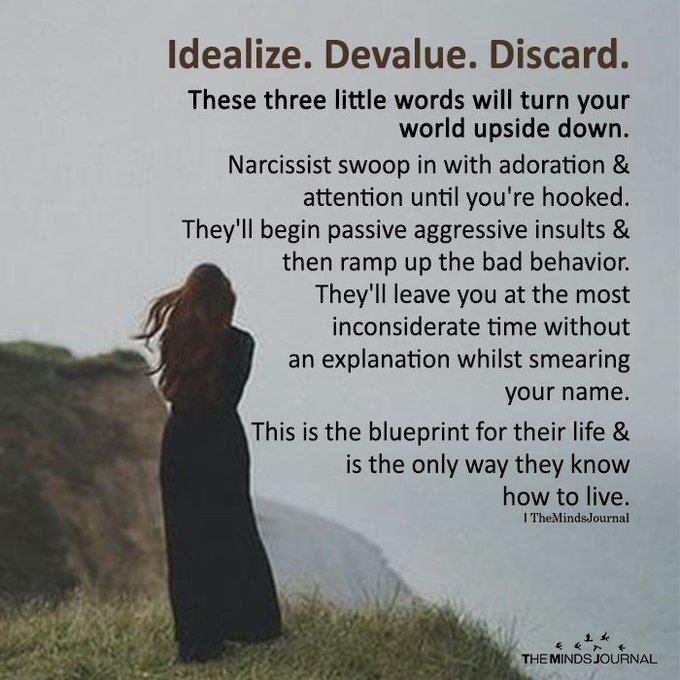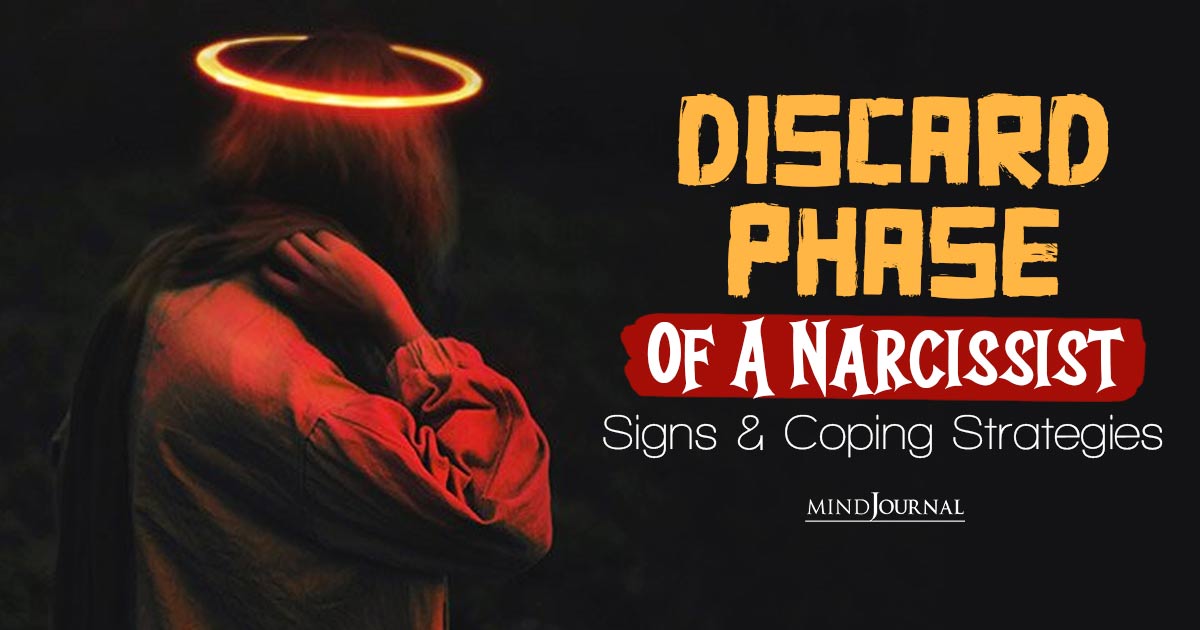Have you ever known someone who was charming and captivating in the beginning only to make you feel empty, invalidated, and discarded at the end? If that is the case then you could have encountered a narcissist during the discard phase of a narcissist.
What is a narcissist discard? Let’s dive into the world of narcissistic personalities and try to understand the discard phase of a narcissist, narcissist discard signs, narcissist discard examples and what happens when you discard a narcissist.
What is a narcissist discard?
The discard phase of a narcissist refers to a part in their cycle where they undervalue and dispose of individuals they used for manipulation and control. This usually comes after idealization (or love bombing) and devaluation stages.
The true colors of narcissists become more apparent during this time when they change from adoration to indifference or even hostility.
For victims, the sudden transformation can be emotionally devastating as they would not easily understand why the narcissist’s behavior suddenly changed.
Related: 3 Phases of A Narcissistic Relationship Cycle: Idealize, Devalue, Discard
Now that we know what is a narcissist discard, let us take a look at narcissist discard signs and narcissist discard examples to get a better idea.

Narcissist Discard Signs
Here are some of the most common signs of the discard phase of a narcissist:
1. Emotional Withdrawal
Sudden emotional withdrawal by the narcissist is one of the main signs of the discard phase. They may appear distant, cold or mute towards your emotional needs.
Conversations that used to be empathic and engaging are now met with apathy or dismissiveness.
2. Devaluation Tactics
A narcissist may undertake devaluation tactics as part of their discard phase so as to lower your self-esteem and self-worth. They might criticize, belittle or even mock you making you feel inadequate or unworthy of their attention or affection.
3. Lack of Empathy
It is well-known that narcissists lack empathy. This deficit becomes even greater during the discard phase where they disregard your feelings, minimize your experiences or hold you accountable for the declining state of your relationship.
4. Gaslighting
Narcissists often employ gaslighting to manipulate you and to distort your perception of reality. In the discard phase, they may now intensify their gaslighting strategy that will make you doubt your sanity, memory and judgment. This is one of the most common narcissist discard signs.
5. Discarding Support Systems
Through an erosion of support systems, narcissists seek to isolate their victims. During this discard stage, they may alienate you from friends and family, leaving you isolated and dependent on them for validation.
Related: The Cruel Reason Behind Why Narcissists Discard You At The Worst Possible Times
Narcissist Discard Examples
To better understand the disturbing dynamics of the discard phase of a narcissist in relationships, which are filled with emotional detachment and manipulation, let’s consider the following narcissist discard examples –
1. Emotional Detachment
Picture yourself being in a relationship with a narcissist who used to be affectionate and caring. Suddenly, they become emotionally detached making you confused about what happened to the love and affection you were getting once upon a time.
Their aloofness can be soul-shattering because it is hard for them to understand why their feelings have changed so much.
2. Verbal Abuse
A narcissist can resort to verbal abuse during the discard phase for control purposes. They may throw insults at you, call names or use degrading language all aimed at lowering your self-esteem while trying to appear superior.
3. Silent Treatment
During the discard phase of a narcissist, many narcissists employ silent treatment as their usual weapon of choice. You might find out that they are ignoring your calls, messages or any pleas for attention which leaves you feeling like you do not exist at all.

Remaining silent over this long period can cause emotional distress, since any attempts made by you towards regaining their love and attention prove futile sometimes.
4. Blame-Shifting
Narcissists are good at blaming victims. These blame-shifting strategies may be intensified in the dumping phase to make you feel accountable for ruining the bond.
They distort facts, twist events and refuse to take responsibility leading you to question reality and your self-worth.
5. Discarding with a New Source of Narcissistic Supply
As narcissists have no capacity to hold healthy emotional relationships, they look for new victims who can give them the attention and validation they crave.
In the discard phase of a narcissist, they could replace you with another source of narcissistic supply that could leave you feeling replaced and discarded.
Related: Narcissistic Devaluation Phase: Why Does A Narcissist Discard You
Jane’s Experience with the Discard Phase of a Narcissist
To better understand what is a narcissist discard, let us consider the narcissist discard examples of Jane and Mark.
Jane’s story provides an instructive example of experiencing the discard phase in a relationship with a narcissist. Mark flattered his way into her heart and assumed the role of her prince charming during their whirlwind romance. Eventually, things got out of hand and Jane found herself caught in a web of manipulation and emotional turmoil.
During the idealization phase, Jane was overwhelmed by love from Mark who constantly complimented her. He met her every need, making her feel that she was his entire world.
However, as time went on, subtle signs of Mark’s narcissistic traits began to surface.
When their relationship continued, however, something changed about his behavior completely. He became critical towards Jane gradually ignoring her feelings and needs while growing emotionally distant.
He would constantly patronize Jane to a point where their conversations that used to be warm and understanding became condescending and indifferent. Blaming Jane for the changes in their dynamics, she was met with gaslighting and blame shifting leading to her doubting herself and her sanity.
This discard phase of a narcissist reached its peak when Mark broke up with Jane unexpectedly and without providing any explanation. Jane remained confused about what had happened; she did not know whether to feel relieved or sad about the whole situation. Her self-esteem was shattered by this sudden discard leaving her feeling inadequate as well as unlovable.
In retrospect, it became clear what Mark wanted all along. In less than no time he had moved on to someone else following his breakup with Jane where he went ahead posting pictures of his new love all over social media. He left Jane like any other object being replaced without any second thoughts.
However, over time, Jane started seeing things more clearly and grew stronger. With the help of friends and therapy, she realized that Mark’s discard phase was not about her worth but rather his insecurities and desire for dominance.

Jane started her journey to recovery by focusing on self-care, setting boundaries, and rebuilding her self-esteem. This way, she would be able to tell when things were not right.
Consequently, Jane turned a negative experience with the discard phase into an opportunity for personal growth and empowerment.
It is important to note that what happened to Jane can happen in many other cases where a narcissist is involved. There are many victims out there who are treated as devalued commodities and deserve better treatment.
Therefore ,we need to enlighten them on this issue so that they can regain their confidence in terms of self-worth if they ever get tangled up with a narcissistic person.
Related: Why Do Narcissists Go Back After Discarding Someone?
What Happens When You Discard a Narcissist
Escaping from a narcissist’s grasp is an empowering yet overwhelming process. Finding the courage to finally discard a narcissist from your life can trigger them and lead to different reactions and outcomes.
It is essential to understand the dynamics of the discard phase of a narcissist as it can empower you to navigate this phase with resilience and go towards healing and personal growth.
1. The Narcissist’s Reaction
A. Narcissistic Rage
Whenever discarded, narcissists often respond with extreme anger and rage. This reaction comes from their injured egos and loss of control and power over you.
They may respond by shouting or even physically assaulting you, trying to get back their dominance and punishing you for having enough courage to walk away.
B. Manipulation and Hoovering
Manipulative tactics are employed by a narcissist after getting over initial rage in order to re-exert their dominance over your life again. These manipulation methods may include love bombing, promises of change or making you second guess your decision about leaving the relationship.
This stage is known as hoovering and it refers to a phase which seeks to lure you back into the toxic cycle.
C. Character Assassination
When they are discarded, narcissists may engage in character assassination that is meant to ruin your social reputation.
They could then go ahead and spread malicious rumors, tell some twisted truths or use your vulnerable, private information shared during the relationship to show you as being unstable, untrustworthy and deserving of ill-treatment.
They do this with the intention of controlling the narrative while invalidating your credibility. This is what happens when you discard a narcissist.
2. Emotional Rollercoaster
A. Relief and Freedom
Discarding a narcissist can initially bring about feelings of relief and freedom. You might feel like a weight has been lifted off your shoulders as you leave behind incessant criticism, manipulation, and emotional turmoil.
This freedom enables you to reclaim who you are in essence by understanding what you deserve.
B. Grief and Loss
Despite its toxicity, there might be a mourning period for either the loss of that relationship or the person you believed the narcissist was during the idealization phase.
It is normal to grieve dreams, hopes, and expectations tied up in a relationship which was based on manipulation and deceit.
C. Emotional Triggers
Similar to the discard phase of a narcissist, the aftermath of discarding a narcissist can be emotionally triggering; leaving one grappling with self-doubt, guilt, shame or fear.
These emotions may resurface repeatedly due to how abuse lingers around and how manipulative narcissists try to maintain control over victims even after break up. This is exactly what happens when you discard a narcissist.

3. Rebuilding and Healing
A. Establishing Boundaries
Discarding a narcissist requires setting and enforcing healthy boundaries. This involves limiting or cutting off contact with the narcissist, both in person and online.
It also means protecting yourself from their attempts to manipulate and hoover you back into the toxic dynamic.
B. Seeking Support
Surrounding yourself with a strong support system is crucial during the healing process. Friends, family, or support groups can provide validation, empathy, and guidance as you navigate the emotional aftermath of discarding a narcissist.
Therapeutic interventions, such as counseling or therapy, can also be immensely beneficial in rebuilding your self-esteem and addressing any trauma.
C. Self-Care and Self-Reflection
Prioritize self-care as you embark on the journey of healing. Engage in activities that bring you joy, practice self-compassion, and focus on rebuilding your sense of self.
Self-reflection plays a vital role in identifying patterns, healing wounds, and developing healthier relationship dynamics moving forward.
D. Embracing Growth and Empowerment
Discarding a narcissist opens up opportunities for personal growth and empowerment. Use this experience as a catalyst for self-discovery and transformation.
Cultivate self-awareness, learn from the red flags you may have missed, and develop a stronger sense of self-worth and resilience.
Removing a narcissist from your life is an important and brave step that enables you to regain control of your own life and well-being. While the aftermath can be difficult, understanding how a narcissist may react and what you may feel can help you navigate this phase with determination and strength.
Related: Exposing A Narcissist And Getting Rid Of Them

Takeaway
The discard phase of a narcissist is very distressing because of emotional withdrawal, devaluation and manipulation. Knowing the signs of this phase can help you protect yourself from further harm and start the healing process.
Always remember that you owe yourself respect and love as well as empathy. Try finding reliable friends or family members or experts who can help you recover from the emotional wounds caused by such toxic relationships
Remember, like everyone else, you deserve a healthy, happy and supportive relationship that nurtures your growth & happiness.
Frequently Asked Questions (FAQs):
What does a narcissist do after discard?
They may find new people to admire them, undervalue those who are no longer useful and seek revenge.
How long does it take to recover from narcissistic discard?
Recovery from narcissistic discard varies, but it involves self-reflection, support, and time. Individual experiences determine the duration of healing.
Why does narcissist discard hurt so much?
Narcissistic discard hurts because of betrayal, manipulation, shattered self-esteem and emotional abuse which leads to deep emotional agony.










Leave a Reply